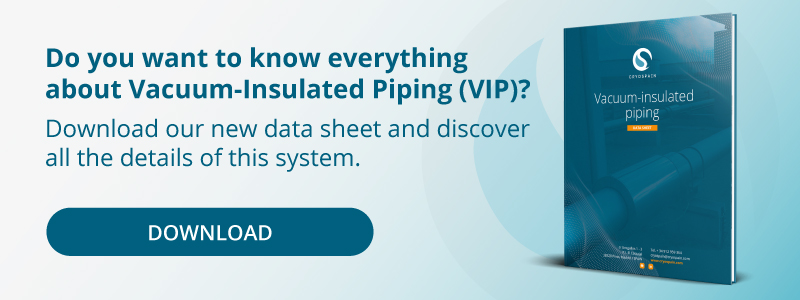Vacuum leak testing is essential to guarantee vacuum equipment remains safe and efficient. It allows to detect potential leaks and thus eliminate them.
From manufacturing to clean energy processes, many industries today rely on vacuum equipment, as the ever-growing applications of cryogenics are explored and employed.
In such a context, being able to perform the right vacuum leak detection methods is crucial. Learn more about vacuum leak detection in our short guide on the topic.
What is vacuum leak testing and why is it important?
In the cryogenic sector, vacuum chambers in equipment are employed to enhance thermal isolation and thus guarantee substances are kept at cryogenic temperatures.
Potential leaks (that is, the escape or entry of gas through small holes) on the other hand, pose a threat to this.
Leaks may present different rates, which means different amounts of gasses pass per a measured unit time. Additionally, there are several reasons why vacuum leaks might take place, which include contamination and outgassing.
This is where vacuum leak testing comes into play, a concept which describes operations enforced to detect potential leaks.
The main reasons to enforce the right vacuum leak detection methods include:
- Safety (many gasses and fluids stored using vacuum equipment are toxic, inflammable, explosive…)
- Product integrity
- Longer user-life both equipment and the substances within
- Comply with environmental and quality standards
- Improved efficiency for cryogenic storage
Types of leaks
There are two main types of leaks:
- Outside-in leaks: these are leaks where the gas and fluid flows into the vessel from an outside source
- Inside-out leaks: the gas or fluid escapes the equipment
You must be interested: Introduction to jacketed piping systems
Vacuum Leak Detection Methods
Bubble tests
Water or liquid are used to observe where froth is created in low-pressure leaks (valid for vacuums of 10-4 mbar).
Pump-down tests
To perform this type of vacuum leak testing, a closed vessel is evacuated until a certain pressure level, after which the inlet valve is closed. This valve is opened again and the time for the vacuum to return to its original level is recorded. After repeating the process a number of times, a leak is detected if the time for the original level of vacuum to return remains constant.
Pressure rise/drop tests
A chart is used to plot vacuum levels and time values after isolating the system and obtaining a certain vacuum level. If a straight line is obtained, a leak is present. However, this method is inconvenient if gas liberation from system walls is taking place.
The pressure drop test is mainly used for tank engineering processes as it works as a vacuum leak detector for rate measurements to 10-4 mbar*l/s.
Helium Leak Testing
Helium being the smallest inner particle that exists, it’s used to detect leaks down to 10-11 mbar L/s.
Therefore, its low mass, low background levels and the fact that it’s non-reactive and available at low costs represent other reasons for helium vacuum leak testing to be one of the most preferable options.
There are two methods for helium leak testing:
- Integral leak testing is valuable to detect if there’s a leak.
- Local leak testing shows where leaks are, although leak rates and sizes might not be available.
The main difference between the two is that the integram method is performed within a gas-proof unit; on the other hand, the local testing method uses a chamber that has been either pressurized with helium or internally evacuated with helium and then uses a helium spray on the chamber’s surface.
Both tests, however, employ a mass spectrometer to analyze potential leaks.
Additionally, these two methods can then be subdivided into “sample under vacuum” and “sample under pressure” options.
Keep reading: Why you should choose vacuum insulated pipes
Performing helium vacuum leak testing
From our experience in cryogenic engineering and generating vacuum and high-vacuum equipment, at Cryospain we perform helium vacuum leak testing to guarantee safety and efficiency. We are experts in testing your cryogenic systems for leaks with state-of-the-art helium tests.
As such, we observe the following steps, which are in compliance with ASME Standard V art 10 ap IV and V:
- We create a vacuum in the inter-chamber space
- The mass spectrometry leak detector is connected. This equipment analyses potential leaked substances and notifies the human team when values are above background levels
- Using a spray, we apply small quantities of helium gas in the desired area for vacuum leak testing
- Joints, welds, valves and other critical parts are scanned
- The vacuum leak detector sounds an alarm in case leaks are present, as the gas will travel to the inter-chamber because of the pressure difference.
- If leaks are detected, they’re repaired
- Then, in order to put the equipment back to functioning, we reconnect the vacuum pump, heat the inner vessel and keep the pump connected. We terminate our operations when the vacuum is stabilized for at least 24 hours
Cryospain: your expert company in vacuum leak testing
As part of our maintenance and after-sales program for vacuum equipment, at Cryospain we provide state-of-the-art helium tests services to our clients.
Through these tests, we’re able to perform vacuum leak testing for cryogenic vessels. The testing is useful for of all sizes, including rangers, dewars and larger pressure tanks. Additionally, depending on the type of equipment, we can provide on-site vacuum leak detection or bring dewars or rangers to our own workshop.
Thanks to these, we’re able to guarantee systems remain efficient and safe to use.
Want to learn more about vacuum leak testing for your equipment? Get in touch with our team and discover how we can help you.











 Contacte-nos
Contacte-nos